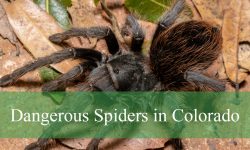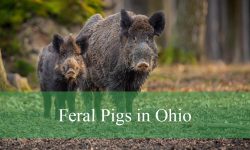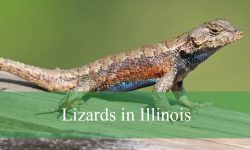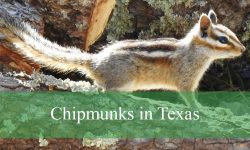Oregon is home to a wide variety of geese that can be seen throughout the year. From large, familiar Canada Geese to less common species like the Snow Goose or Greater White-fronted Goose, these birds are a common sight in wetlands, parks, and open fields. Some stay year-round, while others stop in Oregon during migration.
In this guide, you’ll discover 12 types of geese that live in or pass through Oregon. Each section includes pictures and key identification tips to help you recognize them more easily in the wild.
This list is perfect for anyone interested in learning more about the geese seen across Oregon’s natural landscapes. Whether spotting them by a quiet lake or in a city park, there’s always something new to notice.
Common Geese You Can See in Oregon
Canada Goose (Branta canadensis)
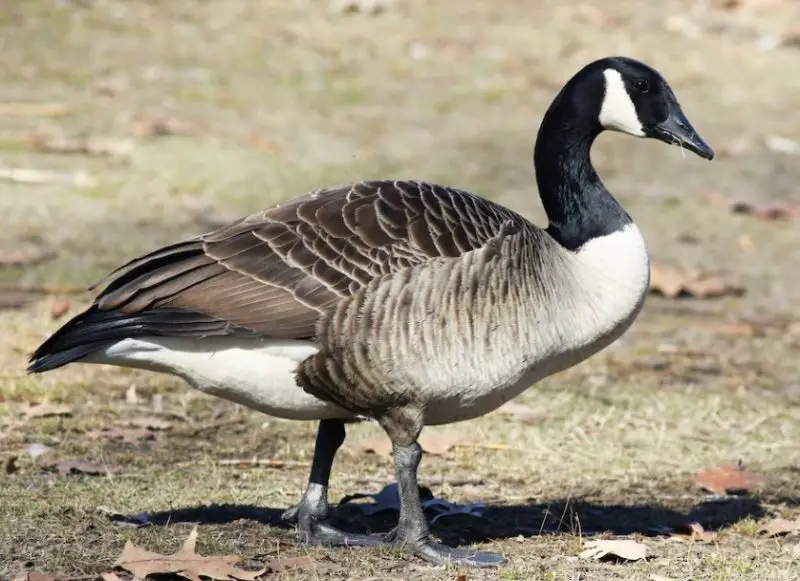
The Canada Goose is one of the most recognizable and widespread waterfowl species in North America. It features a black head and neck, white cheek patches, and a brownish-gray body with paler underparts. Adults are large birds, typically measuring 30 to 43 inches in length with a wingspan of up to 6 feet, and weighing between 7 to 14 pounds. Their graceful flight and distinctive body shape, especially during migration, make them easy to identify from a distance.
In terms of vocalization, Canada Geese are well-known for their loud and honking calls that sound like “a-honk” or “ka-lunk.” These calls are often heard in flight or while feeding, and they serve important roles in communication among flock members. Each goose has a slightly different voice, allowing individuals to recognize mates and family members. They are also known for their alarm calls, which alert others of approaching danger.
Canada Geese thrive in a variety of habitats, including lakes, rivers, wetlands, golf courses, city parks, and agricultural fields. They are adaptable and can live comfortably near human activity, which has contributed to their population growth. Their nesting behavior is highly territorial; females often return to the same nesting sites annually, usually near water and with good visibility to detect predators.
In Oregon, Canada Geese are present year-round in many regions, from the Columbia River to the Willamette Valley. Resident populations are particularly abundant in western Oregon, especially in urban areas like Portland and Eugene. Migratory populations also pass through eastern and southern Oregon during spring and fall, making this species a constant and familiar sight across the state.
Moffitt’s Canada Goose (Branta canadensis moffitti)
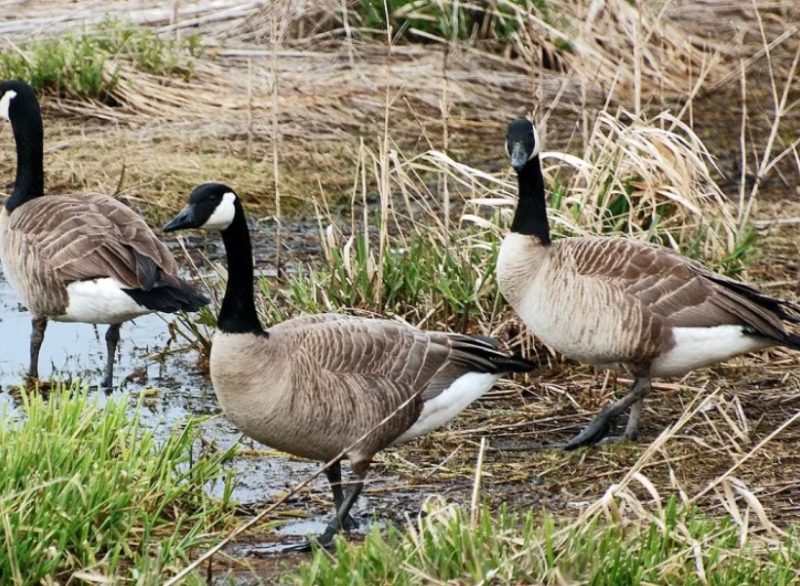
Moffitt’s Canada Goose is a subspecies of the larger Canada Goose complex, distinguished by its relatively larger size and paler breast compared to other subspecies. This goose is among the biggest, with males sometimes exceeding 14 pounds in weight. Like other Canada Geese, it exhibits the characteristic black head and neck with a white chinstrap, but the back and sides tend to be lighter gray, helping birders differentiate it from the darker Dusky Canada Goose.
The call of Moffitt’s Canada Goose is loud and resonant, closely resembling the classic honking of its parent species. However, the deeper tone and slower cadence can sometimes help distinguish it, especially when several subspecies are present in the same area. During courtship and nesting, pairs often communicate using softer murmurs and clucks.
This subspecies prefers open wetlands, ponds, grassy fields, and riversides. It is highly tolerant of urban environments, often seen grazing on lawns and nesting on rooftops or islands in suburban parks. Unlike more migratory forms, Moffitt’s Canada Goose is generally considered non-migratory and forms stable, year-round populations in suitable areas.
In Oregon, Moffitt’s Canada Geese are particularly common in the western part of the state. They are resident birds in the Willamette Valley, Columbia Plateau, and Klamath Basin. Populations are managed for hunting and habitat conservation, and their adaptability has made them one of the most dominant waterfowl types in urban Oregon landscapes.
Dusky Canada Goose (Branta canadensis occidentalis)

The Dusky Canada Goose is a medium-sized, darker-colored subspecies of the Canada Goose. It is smaller than the Moffitt’s but larger than the Cackling Goose, with adults averaging around 6 to 8 pounds. This subspecies is notable for its uniformly dark breast and upperparts, giving it a more shadowy appearance. It also has the classic black neck and head with a white cheek patch, but its darker overall tone sets it apart in mixed flocks.
Its vocalizations are slightly softer and lower-pitched than the standard Canada Goose. The honk is less robust and often described as more nasal, which, along with its plumage, aids in field identification. During the non-breeding season, flocks of Dusky Canada Geese often mix with other subspecies, but their calls can still be distinguished if closely observed.
Dusky Canada Geese have very specific breeding and wintering areas. They breed exclusively in the Copper River Delta of south-central Alaska, one of the most remote and pristine nesting habitats in North America. In winter, they migrate south and are almost entirely restricted to the Willamette Valley in Oregon, where wetlands and refuges have been managed specifically for their conservation.
In Oregon, this subspecies is considered sensitive due to its limited range and small population. Major wintering areas include Fern Ridge Reservoir, Ankeny National Wildlife Refuge, and Finley National Wildlife Refuge. Wildlife biologists monitor Dusky populations closely, and conservation efforts include habitat protection and restricting hunting in key refuge zones.
Cackling Goose (Branta hutchinsii)
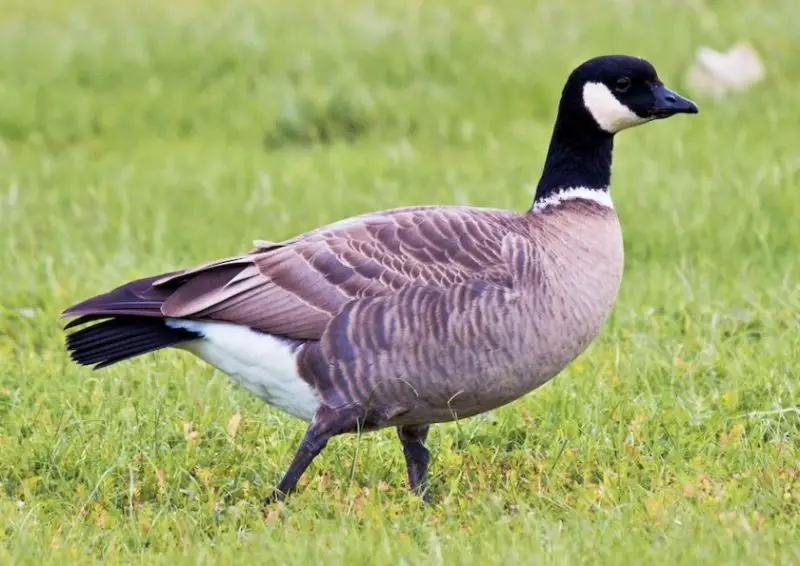
The Cackling Goose was once considered a small Canada Goose until it was given full species status. These geese are noticeably smaller than Canada Geese, weighing only 3 to 6 pounds and measuring about 22 to 30 inches long. They have short necks, stubbier bills, and a more compact body shape. Plumage is similar, with a black head and neck and a white chinstrap, but their proportions are key to distinguishing them in the field.
True to their name, the Cackling Goose emits high-pitched, yelping calls that resemble a rapid “cack-cack-cack.” The sound is very different from the deep honk of Canada Geese and is often described as more squeaky or chattering. These calls are frequently heard during migration and in wintering flocks, especially when geese are taking flight or feeding in groups.
Cackling Geese breed in the Arctic tundra of Alaska and northern Canada and migrate south in large flocks during fall. They prefer shallow wetlands, flooded fields, and agricultural lands during migration and winter. They often forage on leftover grains and grasses, forming large flocks that can number in the thousands. Their small size allows them to forage efficiently in tighter spaces compared to larger geese.
In Oregon, Cackling Geese are most commonly seen in the Willamette Valley and Klamath Basin during fall and winter. They are particularly abundant in late October through February. Refuge areas like Sauvie Island, Baskett Slough, and Ridgefield (just across the Columbia in Washington) are excellent places to observe these small geese in mixed flocks with other species.
Snow Goose (Anser caerulescens)

The Snow Goose is a striking migratory species that comes in two color morphs: the common white morph and the rarer blue morph. White-morph Snow Geese are entirely white with black wingtips, while blue-morph birds have bluish-gray bodies with white heads. Adults measure between 25 and 31 inches in length, with a wingspan of up to 59 inches, and weigh around 5 to 7 pounds.
Snow Geese are very vocal and emit loud, nasal “whouk-whouk” or “owk-owk” calls that are quite different from the honk of Canada Geese. These sounds are often heard in unison from large migrating flocks, creating a chorus that can be heard from miles away. The racket increases when flocks land in fields or take off en masse, which is a spectacular sight and sound experience.
These geese breed in the high Arctic tundra, where they nest in large colonies. In winter, they migrate in enormous flocks to wetlands, estuaries, and agricultural fields, particularly where grain or leftover crops are available. Their feeding behavior often leads to large congregations in open fields, where they graze on grasses, roots, and stubble.
In Oregon, Snow Geese are mainly seen during migration and winter, particularly in the Columbia Basin and southeastern Oregon. Fields near the Klamath Basin, Summer Lake, and Lower Columbia River are reliable spots to observe large flocks. White-morph birds are far more common, but blue morphs are seen regularly in mixed flocks, especially during peak migration in November and February.
Ross’s Goose (Anser rossii)
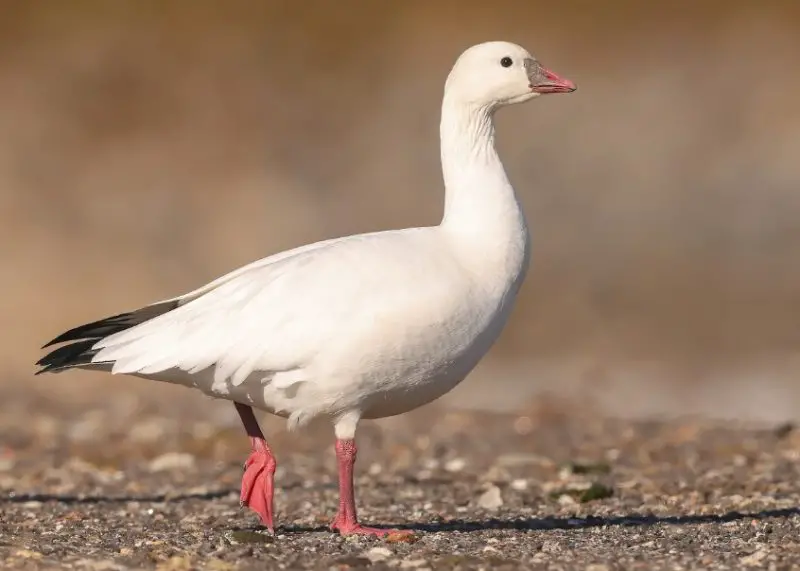
Ross’s Goose is a small white goose that closely resembles the Snow Goose but is noticeably more compact. Adults typically measure 23 to 25 inches in length and weigh between 2.5 to 4 pounds. They have white plumage with black wingtips, a short neck, and a small, stubby bill that is distinctively lacking the “grin patch” seen on Snow Geese. Their rounded head and delicate proportions make them easy to recognize once compared side by side with similar species.
Their vocalizations are high-pitched and often described as squeaky or whiny. These calls differ from the deeper tones of Snow Geese and can help birders pick them out from within mixed flocks. Ross’s Geese are social birds that stay in large flocks during migration and winter, often traveling and feeding alongside Snow Geese. Their constant chatter can be heard especially when they take flight or land.
Ross’s Geese breed in the central Canadian Arctic and migrate south in large numbers during winter. They favor agricultural fields, marshes, and wet grasslands, where they feed on grasses, sedges, and leftover grain. Their small size and adaptability allow them to forage effectively in dense groups, especially in areas with shallow water and soft vegetation.
In Oregon, Ross’s Geese are typically seen in the same areas as Snow Geese—especially in the Columbia Basin, Klamath Basin, and Willamette Valley during winter. They are more common from November to February and are often observed in large flocks with Snow Geese in open fields. Careful observation is required to spot the smaller Ross’s Goose among its larger cousins.
Greater White-fronted Goose (Anser albifrons)
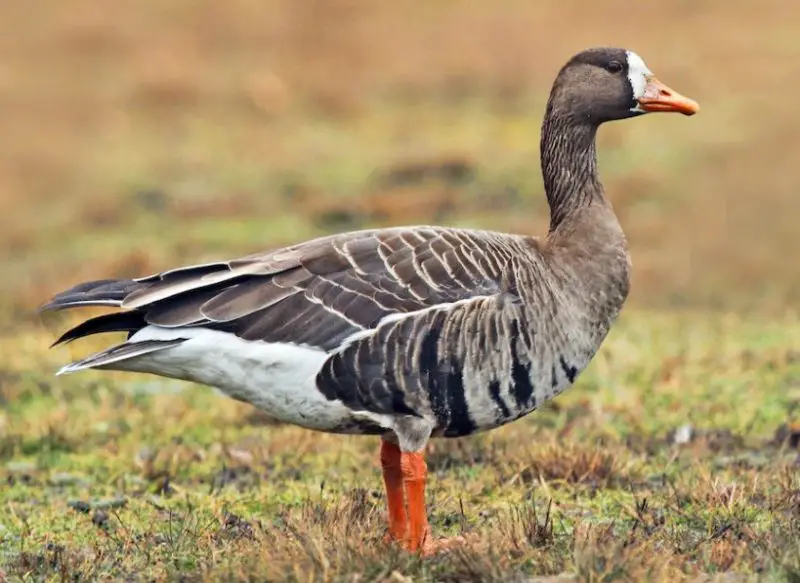
The Greater White-fronted Goose is a medium-sized goose known for its speckled belly and white patch at the base of the bill. Adults measure 25 to 32 inches long and weigh about 4.5 to 6.5 pounds. Their body is brownish-gray with a white rump, orange legs, and a pinkish or orange bill. Their “white-fronted” name refers to the white blaze just above the bill, which is one of its key identifying features.
The calls of Greater White-fronted Geese are loud, high-pitched, and often described as a melodic “kleek-kleek.” These calls differ markedly from those of Canada or Snow Geese and carry over long distances, especially during migration flights. They are highly vocal birds and communicate constantly within flocks, especially when forming tight V-shaped flight formations.
These geese breed in the Arctic tundra and migrate long distances to wintering areas across the southern United States and Mexico. During migration, they stop at wetland areas, lakes, and flooded agricultural lands, where they feed on grains, grasses, and aquatic vegetation. Their strong fidelity to migration routes means they return to familiar stopover points year after year.
In Oregon, Greater White-fronted Geese are commonly seen during spring and fall migration. They are especially abundant in the Klamath Basin, Willamette Valley, and Summer Lake Wildlife Area. Flocks often forage in flooded fields and wet meadows, sometimes mixing with Cackling Geese or Snow Geese. They are sometimes nicknamed “speckle-bellies” due to the distinctive dark spots on their underparts.
Brant (Black Brant) (Branta bernicla nigricans)

The Black Brant is a small, coastal species of goose that is striking in its appearance. It has a black head, neck, and chest, with a small white necklace-like collar on the upper neck. Its body is dark brown to blackish with lighter flanks and a white rump and tail. Adults are compact, measuring about 22 to 26 inches long and weighing 3 to 4 pounds. This coloration gives it a very different look compared to the typical white or gray geese found inland.
Brants are relatively quiet geese, with calls that are soft and conversational, often described as “crrrot” or “rrrott” sounds. Their vocalizations are more subdued than other geese, but in flight or when alarmed, they can become more insistent and nasal. During the breeding season, calls increase in frequency as pairs coordinate nesting duties or defend small territories.
They breed in the high Arctic tundra and winter along the Pacific coast, especially in estuaries and bays where eelgrass is abundant. Eelgrass is their primary winter food source, and their survival depends heavily on healthy coastal ecosystems. Unlike other geese that graze in fields, Black Brants are true marine specialists, rarely straying far from saltwater.
In Oregon, Black Brants are typically found along the coast, particularly in estuarine areas such as Netarts Bay, Yaquina Bay, and Coos Bay. They arrive in large numbers in the late fall and stay through winter, often forming tight flocks that feed in shallow tidal zones. Their coastal distribution makes them a unique and cherished winter visitor for Oregon birdwatchers.
Emperor Goose (Anser canagica)

The Emperor Goose is a rare and beautiful Arctic species that is occasionally observed along the Pacific Northwest coast. Adults are medium-sized, about 26 to 28 inches in length, with gray-barred plumage, a stark white head and nape, and a short pink bill. The legs are bright orange, and the bird has a stocky, rounded appearance. The contrasting white head and dark body give the Emperor Goose a regal look that lives up to its name.
Its calls are low-pitched and somewhat grating, described as short grunts or croaking “guh-guh” notes. These are usually heard during takeoff, flock movement, or while foraging in close proximity to other birds. They are not as vocally active as other geese, but their unique call and plumage help them stand out in a crowd.
Emperor Geese breed in western Alaska and are mostly restricted to the Bering Sea region during migration. They prefer remote, undeveloped coastal habitats, including mudflats, tidal marshes, and rocky shorelines. Unlike inland species, they rely heavily on marine and estuarine ecosystems and feed primarily on sedges, grasses, and algae.
In Oregon, sightings of Emperor Geese are rare and usually limited to coastal areas during winter. Birders have reported occasional individuals at places like Yaquina Head, Bandon Marsh, and Tillamook Bay. Because of their limited global population and strict habitat preferences, these sightings are often noteworthy events in the local birding community.
Tundra Bean-Goose (Anser serrirostris)
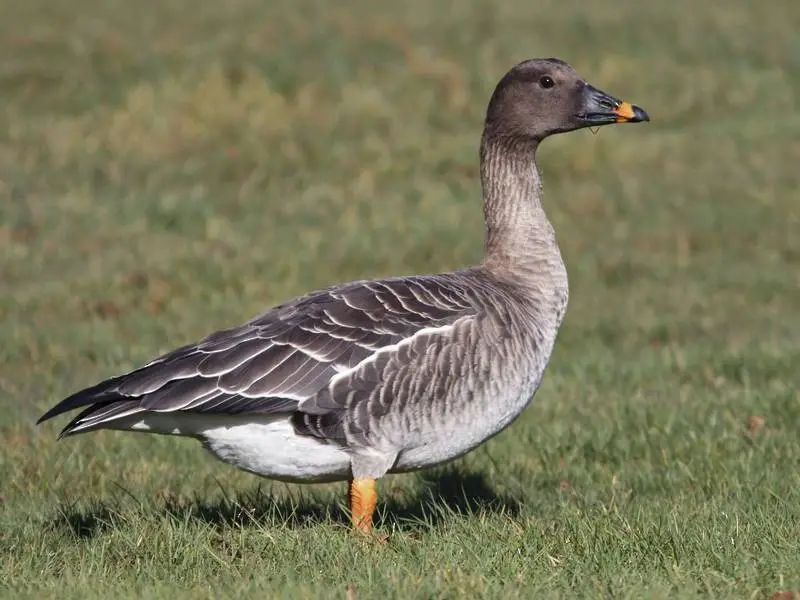
The Tundra Bean-Goose is a rare vagrant in Oregon and much of North America, primarily found in Eurasia. It is a medium-to-large goose with a dark brown-gray body, a thick neck, and a distinctive bill that is mostly black with an orange band across the middle. Adults measure 28 to 34 inches long and weigh between 5 to 7 pounds. Their appearance is similar to the Greater White-fronted Goose but darker and stockier.
The vocalizations of the Tundra Bean-Goose are deep and guttural, usually a nasal “ang-ang” or “ung-ung.” Their calls can be heard during flight and while foraging, but they are not as loud or as frequent as some other geese species. When startled, the entire flock can erupt in a series of alarm calls before taking off in unison.
Native to the Siberian tundra, Tundra Bean-Geese migrate to eastern Asia and occasionally Europe for winter. Very rarely, a few individuals wander across the Bering Strait and are spotted in Alaska or further south along the Pacific coast. These birds prefer wetlands, lakeshores, and coastal flats, where they feed on aquatic vegetation and grasses.
In Oregon, the Tundra Bean-Goose is an accidental visitor, with only a handful of confirmed records. Birders sometimes find them among large flocks of white geese during migration, especially in places like Sauvie Island or the Klamath Basin. Any sighting of this species typically attracts considerable attention due to its rarity and exotic origin.
Swan Goose (Anser cygnoides)
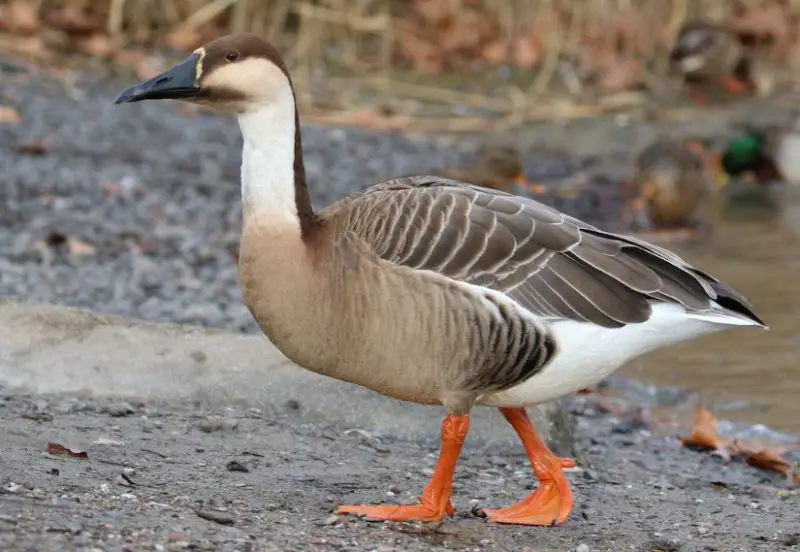
The Swan Goose is a large and distinctive goose native to East Asia but occasionally seen in Oregon as domestic or feral individuals. Wild Swan Geese are lanky and upright in posture, with a brown crown, pale face, and a black bill. They can reach lengths of 30 to 35 inches and weigh up to 9 pounds. Domesticated varieties tend to be heavier and may have a more pronounced forehead knob.
These geese produce a loud, nasal honking call that can resemble a drawn-out “aang” or “aah-ong.” Domesticated forms are more vocal and may display aggressive or alert behavior in captivity. While not native to Oregon, Swan Geese are often heard in ornamental lakes, city ponds, and waterfowl collections, adding to their presence in urban areas.
The wild Swan Goose breeds in Mongolia, China, and southeastern Russia and winters in wetlands and rice fields. It has been domesticated for centuries, leading to numerous escaped or released individuals across the globe. These birds prefer lakes, slow rivers, and ponds, where they forage on aquatic plants, grasses, and grains.
In Oregon, Swan Geese are not considered part of the wild avifauna but are often seen in city parks or on farms. Feral populations are possible around urban lakes, such as in Portland, Eugene, or Salem. While beautiful and unique, they do not contribute to natural migration patterns and are usually the result of human introduction.
Greylag Goose (Anser anser)
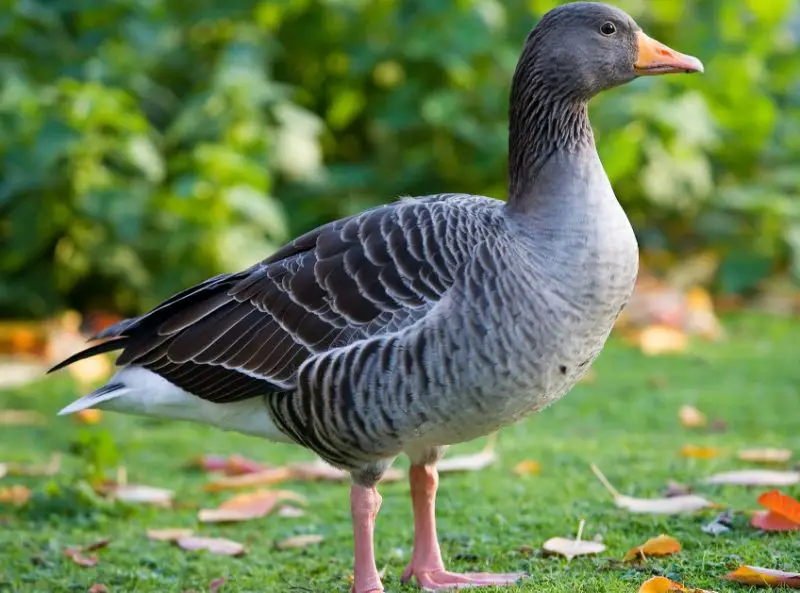
The Greylag Goose is the ancestor of most domestic geese and occasionally appears in Oregon in feral or escaped form. Wild individuals are large and bulky, with grayish-brown plumage, pale belly, orange legs, and a stout orange or pink bill. Adults can grow up to 35 inches long and weigh as much as 10 pounds. Their rounded head and pale coloration contrast with the more patterned wild geese.
Greylag Geese are very vocal and produce a variety of honks, grunts, and squeals. Their calls are loud and somewhat harsh, often heard in gaggles when foraging or taking flight. Domesticated versions may be even more vocal and used to human presence, which can make them seem tame or even aggressive near food sources.
Originally native to Europe and western Asia, Greylag Geese are now found in feral populations worldwide due to domestication. They thrive in farmland, lakes, reservoirs, and parks, where they feed on grasses, grains, and aquatic plants. They often form mixed flocks with other geese in areas with abundant food.
In Oregon, Greylag Geese are sometimes spotted in urban or semi-rural parks, especially where domestic waterfowl are kept. Individuals that escape from farms or ornamental lakes may survive in the wild or form small feral groups. While not naturally occurring in Oregon, these birds are sometimes seen alongside Canada or domestic geese in public green spaces.


